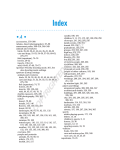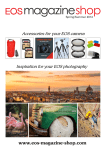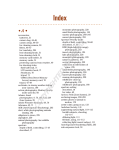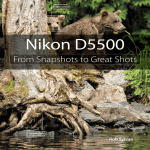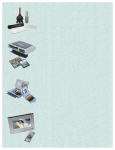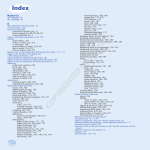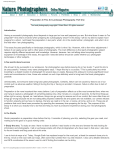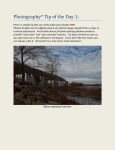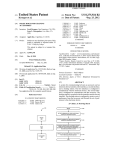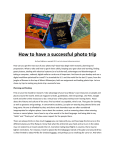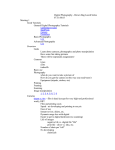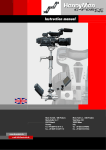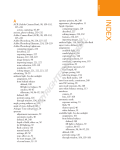Download Wiley Exposure Photo Workshop, 2nd Edition
Transcript
INDEX 18% gray, 78 18% gray cards, 81 RI TE MA D B CO PY RI GH TE accessory flash advantages of, 288–290 attaching, methods for, 288 bounce flash, 289 defined, 310 disadvantages of, 290–291 Fill-in flash mode, 296–298 flash bracket as method for attaching, 288 flexibility of, 290 guide numbers, 289–290, 291 hot shoe as method for attaching, 288 overview, 288 power of, 288–289, 290 sync cord as method for attaching, 288 zoom heads, 290 action photography ghosting, 298 shutter speeds, 54–55 Adams, Ansel The Negative, 18 photographer, 15, 17–18, 177 Zone System, 85 advanced zoom cameras electronic-type viewfinder (EVF), 38 exposure controls, 36, 37–39 afterglow, 177, 198 AI (auto-indexing) lenses, 100 Always-on mode, 301 ambient light, 310 angle of view contrast, used to minimize, 222–223 defined, 310 animal photography and Red-eye Reduction mode, 303–304 aperture automatic lens diaphragms, 100 constant maximum apertures, 99 defined, 310 depth of field, aperture used to manipulate, 104–110 exposure controls, 50–52 f-stop numbering system, 96–98 f-stops, 50–52 landscape photography, 105, 106 lens speed, 98–99 overview, 50 portrait photography, 106 shutter speed relationship, 56–57, 126–128 variable maximum apertures, 99 AL A Aperture Priority mode defined, 310 depth of field, 105–106 exposure controls, 35 overview, 154–155 aperture ring, 96 apps for calculating depth of field, 109 Archer, Fred (Zone System), 85 architecture, assignment for photographing, 31 attaching accessory flash, methods for, 288 Auto exposure mode defined, 310 overview, 150–151, 284 Auto ISO mode, 46 Auto-HDRI mode, 227 auto-indexing (AI) lenses, 100 automatic lens diaphragms, 100 Automatic mode, 150–152 automatic scene modes, 14 automatic white balance, 180 autumn scenes, 269–271 average gray weathered buildings as middle tone subject, 83 B (Bulb) setting, 129 background bokeh, 113–115 dark subjects/light backgrounds, metering, 210–211 light subjects/dark backgrounds, metering, 208–210 backlighting defined, 310 overview, 190–192 white subjects with detail, 212 ballhead defined, 310 overview, 121 battery power needed for flash, 284 black light (long wave ultraviolet) lamps, 162 boats in fog/mist conditions, 264–265 bokeh defined, 310 overview, 113–115 bounce flash defined, 310 overview, 289, 293–294 bounce reflectors, 294 bounce-back, 286 bracketed exposure defined, 310 overview, 89–90 for sunsets, 277–278 INDEX NUMERICS bridge cameras electronic-type viewfinder (EVF), 38 exposure controls, 36, 37–39 buffer, 310 built-in flash advantages of, 283–284 Automatic exposure mode, shooting in, 284 bounce-back, 286 disadvantages of, 285–287 guide numbers, 291 overview, 144 red eye due to, 286 Bulb (B) setting, 129 Burst mode, 310 C cable release, 310 calibration hardware, 30 monitor, 28–29 software, 30 camera obscura defined, 310 described, 52 camera RAW advantages of, 232–233 for autumn scenes, 269 defined, 315 disadvantages of, 231, 233 dSLR camera support, 41–43 JPEG file format compared, 231–232 JPEG+RAW file format, 313 overview, 231–233 for snow scenes, 273 style modes, 16–17 white balance, 179, 232–233 camera shake, 128 camera vision versus human vision, 19–23 Canon Picture Styles, 16 Speedlite, 305 Cape Light (Meyerowitz), 177 card reader, 311 carnival lights as subject for night photography, 248–249 Carr, Pete (HDR Photography Photo Workshop), 227 catchlight, 311 CCD chip, 311 cell phone cameras, 44 Center for Creative Photography, 15 center-weighted metering defined, 311 matrix metering compared, 70 spotlit buildings, 254 TTL (through-the-lens) meters, 69–71 318 city skylines as subject for night photography, 250–251 tripods used for shooting, 120 city street scenes as subject for night photography, 251–252 clear blue sky as middle tone subject, 83 clipping warnings, 209 Close-up mode, 168–171, 299–303 close-up photography backlighting, 190–191 depth of field, 117–119 sidelighting, 190 cloud formations, 267 cloudy day white balance setting, 180 cloudy days diffuse light, 194–195 heavy overcast light, 196 CMOS chip, 311 CMYK, 311 color balance, 298–299 color contrast metering, 217–218 strong, 218–219 color management, 30 Color Management for Digital Photographers For Dummies (Padova & Mason), 30 color temperature cool/warm color balance, 298–299 defined, 311 night photography, 241 overview, 178 colorcast, 311 ColorSync utility, 30 commercial labs exposure element and, 28 finding, 28 compact digital cameras and depth of field, 115–117 compact point-and-shoot cameras, 35–37 comparative photo sets, 120 compression, 311 constant maximum apertures, 99 continuous lighting, 311 contrast angle used to minimize, 222–223 color contrast, strong, 218–219 as creative element, 223–224 dynamic range, 218 exposure problems corrections, 9–10 fill-in flash used to manage, 220–221 HDRI (High Dynamic Range Imaging), 226–227 histograms, 230–231 overview, 218–219 reflectors used to manage, 220 shadows as design element, using, 223 shadows used to create modeling effects and establish form, 225–226 silhouettes, 227–229, 234 time of day for shooting used to manage, 221 using, 223–226 contrast range, 311 cool color balance, 298–299 correct exposure (technically) good exposures preferred to, 11 mood of photograph, 25–26 myth of, 17 overview, 13–14 Correll, Robert (HDR Photography Photo Workshop), 227 creative element contrast, 223–224 exposure, 4 shutter speed, 132 white balance, 183–185 Creative Shutter Speed: Master Your Camera’s Most Powerful Control (Doeffinger), 129 crop factor, 311 Curves feature (Photoshop), 217 custom white balance, 183 D dappled daylight, metering, 217 dark skin as middle tone subject, 83 dark subjects with light backgrounds, metering, 210–211 metering, 213–214 dawn, 198 daylight afterglow, 177, 198 contrast, managing, 221 dappled daylight, 217 dawn, 198 golden hours, 200–201 lighting direction, 185–192 metering white subjects with detail in, 211–213 midday lighting, 199–200 overview, 176–177, 197 quality of light, 193–197 shooting the same scene at different times of day, 177–178 time of day, 177–178, 197–201 twilight, 198–199 white balance settings, 178–185 dedicated flash, 291 default mode ISO speed, 46 defocus control, 114 depth of field Aperture Priority mode, 105–106, 154 aperture used to manipulate, 104–110 apps for calculating, 109 close-up photography, 117–119 compact digital cameras, 115–117 INDEX INDEX creative power of, 100–103 defined, 311 factors affecting, 104–114 handheld depth-of-field guide, 109 isolating subject by limiting, 121 large apertures used for extracting subjects, 109–110 LCD display used to view, 109 lens focal length as factor in, 110–111 macro photography, 117–119 middle range apertures used for “safe” subjects, 106–107 Shutter Priority Mode, 156–159 small apertures used for expansive detail, 106 subject distance as factor in, 112–113 tripod use, 119–122 depth of field scale defined, 311 described, 109 depth-of-field preview button, 109 design, 311 difficult situations for metering, 207–218 diffuse light, 194–195 diffuser, 311 digital cameras categories of, 35–36 EXIF data recorded on, 22 histograms, 12 LCD panel, 12 light-metering features, 11 metadata recorded on, 22 scene modes, 14 style modes, 16–17 tips on using, 11–15 digital negative (DNG) format, 312 digital noise defined, 314 ISO speed, 46, 47–49 long exposure times, 146 digital single lens reflex cameras. See dSLR digital zoom, 311 dimly lit interiors and shutter speed, 144–146 direction of light backlighting, 190–192 front lighting, 187–189, 202 overview, 185–187 sidelighting, 190 top lighting, 189–190, 199–200 direction of motion as factor in shutter speed, 135–137 distance from subject as factor in shutter speed, 139–140 DNG (digital negative) format, 312 Doeffinger, Derek Creative Shutter Speed: Master Your Camera’s Most Powerful Control, 129 photographer, 45, 68, 120, 137, 142 319 driver, 312 dSLR advantages of, 40–43 defined, 312 depth-of-field preview button, 109 exposure controls, 36, 40–44 lens interchangeability, 41 Manual Exposure mode, 40–41 Manual mode, 89 mirrorless interchangeable lens (MILC) cameras compared, 39 RAW format support, 41–43 when to purchase, 44 dynamic range, 311 E Edgerton, Harold E. (inventor of the electronic flash), 282 18% gray, 78 18% gray cards, 81 electronic cable release, 245 electronic flash accessory, 288–291 Always-on mode, 301 battery power needed for, 284 bounce, 293–294 bounce reflectors, 294 built-in, 283–287 Close-up mode, 299–303 color balance, 298–299 dedicated, 291 Fill-in flash mode, 296–298 flash off, 304 Flash-on mode, 297 Forced mode, 297, 301 guide numbers, 291–293 history of, 282 invention of, 282 modes, 295–304 multiple flash units (wireless), 304–305 in night photography, 242 Night scene modes, 299 overview, 282 Red-eye Reduction mode, 303–304 sync speeds, 298 TTL (through-the-lens), 282–283 wireless flash technology, 304–305 electronic flash setting, 181 electronic-type viewfinder (EVF), 38 EV (exposure value), 312 evaluative meters, 66–69 EVIL (electronic viewfinder, interchangeable lens) cameras. See MILC exaggerating motion and shutter speed, 140–144 EXIF data recorded on digital cameras, 22 320 experience with tonal range, 9 value of, 15 with visualization, 19 ExpoDisc, 183 exposure creating a good, 6–7 creative element, 4 defined, 5, 312 importance of, 4–5 overexposure, 6 overview, 4–5 subjectivity in choosing, 17–18 technically correct, 13–14 underexposure, 6 exposure bracketing defined, 312 overview, 89–90 exposure compensation, 87–88 exposure controls advanced zoom cameras, 36, 37–39 Aperture Priority mode, 35, 154–155 Automatic mode, 150–152 dSLR cameras, 36, 40–44 ISO speed, 45–49 lens aperture, 50–52 Manual exposure mode, 159–164 mirrorless interchangeable lens (MILC) cameras, 36, 39 overview, 34–35 point-and-shoot cameras, 35 point-and-shoot (compact) cameras, 35–37 Programmed mode, 152 Shutter Priority mode, 35, 156–159 shutter speed, 52–57 subcompact cameras, 36–37 exposure lock, 89 exposure value (EV), 312 exposure-lock button, 70–71 extension tube, 312 external flash advantages of, 288–290 attaching, methods for, 288 bounce flash, 289 defined, 310 disadvantages of, 290–291 Fill-in flash mode, 296–298 flash bracket as method for attaching, 288 flexibility of, 290 guide numbers, 289–290, 291 hot shoe as method for attaching, 288 overview, 288 power of, 288–289, 290 sync cord as method for attaching, 288 zoom heads, 290 extraction apertures, 109 Eyedropper tool (Photoshop), 210 F face-detection technology, 297 fall foliage, 269–271 fast glass, 98 fast lens night photography, fast lens versus higher ISO speeds in, 240 overview, 98 faster shutter speeds, 54–55, 56 Ferris wheel as subject for night photography, 248–249 fill-in flash contrast, managing, 220–221 defined, 312 overview, 296–298 film cameras and ISO speed, 45 filters fog, 264 graduated neutral density, 312 neutral density, 141, 155, 314 polarizing, 268, 270, 314 star effect, 244 fireworks displays multiple bursts, capturing, 257–258 night photography, as subject for, 257–258 single exposure for, 258 flash accessory, 288–291 Always-on mode, 301 battery power needed for, 284 bounce, 293–294 bounce reflectors, 294 built-in, 283–287 Close-up mode, 299–303 color balance, 298–299 dedicated, 291 Fill-in flash mode, 296–298 flash off, 304 Flash-on mode, 297 Forced mode, 297, 301 guide numbers, 291–293 history of, 282 invention of the electronic flash, 282 modes, 295–304 multiple flash units (wireless), 304–305 in night photography, 242 Night scene modes, 299 overview, 282 Red-eye Reduction mode, 303–304 sync speeds, 298 TTL (through-the-lens), 282–283 wireless flash technology, 304–305 flash bracket as method for attaching accessory flash, 288 INDEX INDEX flash off, 304 flash sync speed defined, 312 overview, 298 flashlights, 243, 255 Flash-on mode, 297 flexibility of accessory flash, 290 Flickr, 227 fluorescent setting for white balance, 181–182 focal length, 312 focal plane, 312 fog and mist, 262–265 fog filters, 264 Forced mode, 297, 301 foreground for sunrises, 279 for sunsets, 279 freezing motion, shutter speed for, 132–140 front lighting, 187–189, 202 front-curtain sync defined, 312 overview, 299 f-stop defined, 312 overview, 50–52 f-stop numbering system, 96–98 G ghosting, 298 golden hour defined, 312 overview, 200–201 graduated neutral density filter, 312 gray card defined, 312 described, 81 gray stone (in average light) as middle tone subject, 83 gray value overview, 78–79 problem situations for light meters, 80–82 shortcuts to middle tones, 82–85 green grass in sunlight as middle tone subject, 83 green mode, 150–151 guide numbers, 291–293 H halation, 244, 247 handheld depth-of-field guide, 109 handheld meters incident-light meters, 76 overview, 74–75 reasons for using, 74 reflected-light meters, 75–76 spot meters, 76–78 321 handheld shots, shutter speed for, 128 harbors in fog/mist conditions, 264 hard light, 194 hardware calibration, 30 HDR Photography Photo Workshop (Carr & Correll), 227 heavy overcast light, 196 hiding the sun behind something opaque during sunsets, 277–278 High Dynamic Range imaging (HDRI or HDR), 213, 226–227, 313 high key defined, 313 metering high key scenes, 214–216 highlight detail described, 208 for snow scenes, 272–273 histogram advantages of, 230–231 contrast, 230–231 defined, 313 disadvantages of, 230–231 interpreting, 12 overview, 230–231 history of flash, 282 HoodLoupe (Hoodman), 208 hot shoe defined, 313 described, 288 Hue control (Photoshop), 229 human vision versus camera vision, 19–23 I image sensor, 313 image stabilization with tripods, 119–120 image-editing programs, 13 importance of exposure, 4–5 incident-light meters handheld meters, 76 light meters, 76 indoor photography and Shutter Priority mode, 158–159 infrared light, 313 invention of the electronic flash, 282 ISO speed Auto ISO mode, 46 default mode, 46 defined, 313 digital noise, 46, 47–49 experimentation with, 58 exposure controls, 45–49 film cameras, 45 Manual ISO mode, 46 manually setting, 45 overview, 45–46 isolating subject by limiting depth of field, 121 322 J Jackson, William Henry (photographer), 132 JPEG file format defined, 313 RAW file format compared, 231–232 and style modes, 16–17 white balance, 179 JPEG+RAW file format, 313 K Kelvin scale defined, 313 described, 178 L Landscape exposure mode defined, 313 overview, 164–166 landscape photography Aperture Priority mode, 154 autumn scenes, 269–271 backlighting, 190–191 lens aperture, 105, 106 sidelighting, 190 stormy skies, 267 Landscape style mode, 16 large apertures used for extracting subjects, 109–110 LCD display depth of field, used to view, 109 reviewing exposures on, 12 lens aperture automatic lens diaphragms, 100 constant maximum apertures, 99 defined, 310 depth of field, aperture used to manipulate, 104–110 exposure controls, 50–52 f-stop numbering system, 96–98 f-stops, 50–52 landscape photography, 105, 106 lens speed, 98–99 overview, 50 portrait photography, 106 shutter speed relationship, 56–57, 126–128 variable maximum apertures, 99 lens focal length changing, 111 depth of field, 110–111 lens speed aperture size factors, 98–99 fast lenses, 98 price of lens in relation to, 99 prime lenses, 98, 99 single-focal-length lenses, 98, 99 slow lenses, 98 zoom lenses, 98–99 Lensbaby Composer, 161 lenses defined, 313 interchangeability, 41 longest lens used to shoot sunsets, 277 macro, 314 prime, 98 slow, 98 wide-angle, 110–111 light meter center-weighted meters, 69–71 defined, 313 evaluative meters, 66–69 gray value, 78–85 handheld meters, 74–78 how it works, 62–65 incident-light meters, 76 matrix meters, 66–69 multi-segment meters, 66–69 overview, 62 problem situations for, 80–82 reflected-light meters, 75–76 shortcuts to middle tones, 82–85 spot meters, 76–78 TTL (through-the-lens), 64–74 light metering bracketing, 89–90 color contrasts, 217–218 dappled daylight, 217 dark subjects, 213–214 dark subjects/light backgrounds, 210–211 difficult situations for, 207–218 on digital camera, 11 exposure compensation, 87–88 exposure element, 9 exposure lock, 89 high-key scenes, 214–216 light subjects/dark backgrounds, 208–210 low-key subjects, 213–214 manual exposure, 89 night photography, 242–243 spot metering, 72–74 sunsets away from the sun, 276 white subjects with detail, 211–213 Zone System, 85–87 light quality defined, 313 diffuse light, 194–195 hard light, 194 INDEX INDEX heavy overcast light, 196 normal light, 193–194 overview, 193 light subjects/dark backgrounds, metering, 208–210 lighting. See also natural light black light (long wave ultraviolet) lamps, 162 off-camera flash, 162 studio, 162 lighting direction backlighting, 190–192 front lighting, 187–189, 202 overview, 185–187 sidelighting, 190 top lighting, 189–190, 199–200 long exposures versus higher ISO speeds in night photography, 240 long exposures/steady camera and shutter speed, 141–142 long wave ultraviolet lamps, 162 longest lens used to shoot sunsets, 277 low key defined, 313 metering low key subjects, 213–214 LumiQuest, 294 M macro lens, 314 macro photography, 117–119 manual, importance of reading your camera’s, 34 manual exposure, 89 Manual exposure mode city street scenes, 251 dSLR cameras, 40–41 overview, 159–164 shutter speed, 143 for sparklers, 255 for traffic streaks, 246 Manual ISO mode, 46 manually setting ISO speed, 45 manually setting white balance, 182 Mason, Don (Color Management for Digital Photographers For Dummies), 30 master photographers, studying work of, 14–16 matrix meter center-weighted meters compared, 70 fog/mist conditions, 265 overview, 66–69 TTL (through-the-lens) meters, 66–69 McNally, Joe (photographer), 305 medium gray, 78 Meola, Eric (photographer), 177 metadata defined, 314 recording, 22 323 metering bracketing, 89–90 color contrasts, 217–218 dappled daylight, 217 dark subjects, 213–214 dark subjects/light backgrounds, 210–211 difficult situations for, 207–218 on digital camera, 11 exposure compensation, 87–88 exposure element, 9 exposure lock, 89 high-key scenes, 214–216 light subjects/dark backgrounds, 208–210 low-key subjects, 213–214 manual exposure, 89 night photography, 242–243 spot metering, 72–74 sunsets away from the sun, 276 white subjects with detail, 211–213 Zone System, 85–87 metering modes, 314 Meyerowitz, Joel (Cape Light), 177 midday lighting, 199–200 middle range apertures used for “safe” subjects, 106–107 middle tones average gray weathered buildings, 83 clear blue sky, 83 dark skin, 83 defined, 314 gray stone (in average light), 83 green grass in sunlight, 83 identifying, 91 light metering, 82–85 overview, 77 red-brick buildings, 83 MILC (mirrorless interchangeable lens camera) defined, 314 dSLR compared, 39 exposure controls, 36, 39 mist, 262–265 monitor calibration hardware, 30 overview, 28–29 software, 30 mood exposure element, 23–27 technically correct exposures and, 25–26 moon as subject for night photography, 259 motion shots, shutter speed for, 140–144 moving subjects, shutter speed for, 129–131 multiple fireworks bursts, capturing, 257–258 multiple flash units (wireless), 304–305 multi-segment meters, 66–69 Muybridge, Eadweard (photographer), 134 324 N natural light afterglow, 177 contrast, time of day for shooting used to manage, 221 dappled daylight, 217 lighting direction, 185–192 metering white subjects with detail in, 211–213 overview, 176–177 quality of light, 193–197 shooting at different times of day, 177–178 time of day, 177–178, 197–201 white balance settings, 178–185 nature photography color contrasts, 218 silhouettes, 227–229 The Negative (Adams), 18 neon signs as subject for night photography, 246–248 neutral balance automatic, 180 cloudy day setting, 180 creative element, 183–185 custom, 183 daylight setting, 180 defined, 315 electronic flash setting, 181 fluorescent setting, 181–182 manipulating, 183–185 night photography, 241 overview, 179 preset, 183 RAW file format, 232–233 reasons for manually setting, 182 selective settings, 180 shade or open shade setting, 180 tungsten setting, 180 neutral density filter defined, 314 described, 141, 155 Neutral Picture Style mode, 16 Niépce, Joseph Nicéphore (photographer), 50 night markets as subject for night photography, 252–253 night photography carnival lights as subject for, 248–249 city skylines as subject for, 250–251 city street scenes as subject for, 251–252 color temperature, 241 fast lens versus higher ISO speeds, 240 Ferris wheel as subject for, 248–249 fireworks displays as subject for, 257–258 flash use, 242 flashlight used during, 243 halation, 244, 247 long exposures versus higher ISO speeds, 240 Manual exposure mode, 162–164 metering, 242–243 moon as subject for, 259 neon signs as subject for, 246–248 night markets as subject for, 252–253 overview, 238–240 sharpness in, 244–245 Shutter Priority mode, 158–159 shutter release, methods for, 245 sparklers as subject for, 254–256 spotlit buildings as subject for, 254 star effect filters used during, 244 steadying camera without tripod, methods for, 240 subjects for, 246–258 time exposures, 254–256 traffic streaks as subject for, 246 white balance, 241 Night-portrait mode, 167–168 Night-scene mode described, 167, 299 for sparklers, 255 Nikon Picture Controls, 16 Speedlight, 305 noise defined, 314 ISO speed, 46, 47–49 long exposure times, 146 normal light, 193–194 notes on your photographs metadata, digital cameras’ recording of, 22 visualization skills improved by taking, 21 Nüchterlein, Karl (engineer/inventor), 65 O off-camera flash, 162 Oglesbee, Brian (photographer), 177 open shade white balance setting, 180 optical viewfinder, 314 optical zoom, 314 overexposure defined, 314 described, 6 reasons for, 6–7 P Padova, Ted (Color Management for Digital Photographers For Dummies), 30 panning defined, 314 shutter speed, 140, 142–143 Panorama mode, 171 INDEX INDEX pan-tilt heads, 121, 141 parallax error, 314 peak of motion as factor in shutter speed, 137–139 pentaprism, 314 photographers Ansel Adams, 15, 17–18, 177 Brian Oglesbee, 177 Carleton E. Watkins, 132 Derek Doeffinger, 45, 68, 120, 137, 142 Eadweard Muybridge, 134 Edward Steichen, 15 Eric Meola, 177 Fred Picker, 22 Galen Rowell, 177 Gavin Zau, 136–137, 252–253 Jennica Reis, 15, 102 Joe McNally, 305 Joseph Nicéphore Niépce, 50 Leonard Lee Rue, 209 master photographers, studying work of, 14–16 Pete Turner, 177 William Henry Jackson, 132 photography, studying, 14–16 Photomatix, 227 Photoshop (Adobe) Curves feature, 217 exposure corrections, 13 Eyedropper tool, 210 Hue control, 229 Saturation control, 229 software calibration, 30 Picker, Fred (photographer), 22 Picture Controls (Nikon), 16 Picture Styles (Canon), 16 pixel, 314 Plowden, David (Vanishing Point), 177 point-and-shoot cameras defined, 314 exposure controls, 35 point-and-shoot (compact) cameras, 35–37 polarizing filter defined, 314 for fall foliage, 270 rainbows, 268 portable reflectors, 220 Portrait mode defined, 315 described, 168 portrait photography backlighting, 190–191 bracket-mounted flash for location, 288 flash, taking a nighttime portrait with, 306 flash used in, 191 lens aperture, 106 continued 325 portrait photography (continued) low-key subjects, 214 Red-eye Reduction mode, 303 reflectors used in, 191 wireless flash technology, 305 Portrait Style mode, 16, 17 power of accessory flash, 288–289, 290 preset white balance, 183 price of lens in relation to lens speed, 99 prime lenses, 98, 99 problem situations for light meters, 80–82 Programmed mode, 152 Q quality of light diffuse light, 194–195 hard light, 194 heavy overcast light, 196 normal light, 193–194 overview, 193 quick-release mounts for tripods, 121 quick-release plate, 315 R rainbows, 268–269 rainy days, 266–267 range for shutter speed, 128–129 RAW file format advantages of, 232–233 for autumn scenes, 269 defined, 315 disadvantages of, 231, 233 dSLR camera support, 41–43 JPEG file format compared, 231–232 JPEG+RAW file format, 313 overview, 231–233 for snow scenes, 273 style modes, 16–17 white balance, 179, 232–233 rear-curtain sync defined, 315 described, 299 red eye built-in flash, due to, 286 defined, 315 red-brick buildings as middle tone subject, 83 red-eye reduction, 315 Red-eye Reduction mode, 303–304 reflective light meter, 75–76, 315 reflectors contrast, managing, 220 portable, 296 326 Reis, Jennica (photographer), 15, 102 remote shutter release, 245 resolution, 315 Rowell, Galen (photographer), 177 Rue, Leonard Lee (photographer), 209 Rue Groofwin Pod (Leonard Rue Enterprises), 209 S Sandburg, Carl (poet), 262–263 Saturation control (Photoshop), 229 scene modes avoiding, 14 Close-up mode, 168–171 Landscape mode, 164–166 Night-portrait mode, 167–168 Night-scene mode, 167 overview, 164 Panorama mode, 171 Portrait mode, 168 Sports/Action mode, 166–167, 172 scouting locations for sunsets, 275–276 Seascape style mode, 16 selective focus, 315 selective white balance settings, 180 settings for shutter speed, 128–129 shade or open shade white balance setting, 180 shadows as design element, 223 used to create modeling effects and establish form, 225–226 sharpness in night photography, 244–245 shutter, 315 Shutter Priority mode defined, 315 exposure controls, 35 overview, 156–159 shutter speed, 143 shutter release, methods for, 245 shutter release button, 70 shutter speed action shots, 54–55 aperture relationship, 56–57, 126–128 B (Bulb) setting, 129 choosing, 129–131 creative power of, 132 defined, 315 dimly lit interiors, 144–146 direction of motion as factor in, 135–137 distance from subject as factor in, 139–140 exaggerating motion, 140–144 exposure controls, 52–57 faster shutter speeds, 54–55, 56 freezing motion, 132–140 handheld shots, 128 long exposures/steady camera, 141–142 Manual exposure mode, 143 motion shots, 140–144 for moving subjects, 129–131 overview, 52, 54–56 panning effects, 140, 142–143 peak of motion as factor in, 137–139 range for, 128–129 settings for, 128–129 Shutter Priority Exposure mode, 143 slower shutter speeds, 56 for still subjects, 129–131 stop-action shots, 132–140 subject speed as factor in, 134–135 zoom effects, 143–144 shutters, 52–53 sidelighting defined, 315 described, 190 white subjects with detail, 212 silhouettes, 227–229, 234 single exposure for fireworks displays, 258 single-focal-length lenses constant maximum aperture, 99 lens speed, 98, 99 slave, 315 slow lenses, 98 slower shutter speeds, 56 small apertures used for expansive detail, 106 snow scenes, 272–273 soft light, 315 software calibration, 30 sparklers as subject for night photography, 254–256 speed (lens) aperture size factors, 98–99 fast lenses, 98 price of lens in relation to, 99 prime lenses, 98, 99 single-focal-length lenses, 98, 99 slow lenses, 98 zoom lenses, 98–99 sports photography Fill-in flash mode, 298 Shutter Priority mode, 158 wireless flash technology, 304, 305 Sports/Action mode, 166–167, 172 spot meter defined, 315 overview, 76–78 spot metering TTL (through-the-lens) meters, 72–74 wildlife photography, 74 spotlit buildings as subject for night photography, 254 INDEX INDEX star effect filters used during night photography, 244 steadying camera without tripod, methods for, 240 Steichen, Edward (photographer), 15 still subjects, shutter speed for, 129–131 stop-action shots, 132–140 stormy skies, 267–268 studio lighting, 162 studying photography, 14–16 style modes disadvantages of, 16–17 experimentation with, 17 JPEG format, 16–17 landscape, 16 Neutral Picture Style, 16 overview, 16–17 portrait, 16, 17 RAW format, 16–17 seascape, 16 vivid, 16 subcompact cameras, 36–37 subject distance as factor in depth of field, 112–113 subject modes avoiding, 14 Close-up mode, 168–171 Landscape mode, 164–166 Night-portrait mode, 167–168 Night-scene mode, 167 overview, 164 Panorama mode, 171 Portrait mode, 168 Sports/Action mode, 166–167, 172 subject speed as factor in shutter speed, 134–135 subjectivity in choosing exposure, 17–18 subjects for night photography, 246–258 sunrises foreground, shooting with an interesting, 279 shooting, 273–277 sunsets bracketing exposures by a full stop or more, 277–278 foreground, shooting with an interesting, 279 hiding the sun behind something opaque, 277–278 longest lens used to shoot, 277 metering away from the sun, 276 overview, 273–274 scouting locations for, 275–276 silhouettes, 229 super zoom cameras electronic-type viewfinder (EVF), 38 exposure controls, 36, 37–39 switching between TTL (through-the-lens) meters, 66 sync cord as method for attaching accessory flash, 288 sync speed defined, 312 overview, 298 327 T technically correct exposures good exposures preferred to, 11 mood of photograph, 25–26 myth of correct exposures, 17 overview, 13–14 telephoto lens depth of field, 110–111 fog/mist conditions, 265 thought process for taking a photograph, 4 through-the-lens meters. See TTL (through-the-lens) meters time exposures and night photography, 254–256 time of day afterglow, 198 contrast, managing, 221 dawn, 198 golden hours, 200–201 midday lighting, 199–200 overview, 197 shooting the same scene at different, 177–178 twilight, 198–199 tonal range dynamic range, 218 experience with, 9 exposure element, 5 overexposure, 6–7 spot metering, 77 underexposure, 6–7 top lighting, 189–190, 199–200 traffic streaks as subject for night photography, 246 travel photography lens aperture, 106 top lighting, 189 tripods ballheads, 121 city skylines at night, 120 comparative photo sets, 120 defined, 315 image stabilization with, 119–120 overview, 119–122 pan-tilt heads, 121, 141 purchasing, 121 quick-release mount, 121 using, 119–122 TTL flash, 282–283 TTL (through-the-lens) meters center-weighted meters, 69–71 defined, 315 matrix meters, 66–69 overview, 64–66 spot metering, 72–74 switching between, 66 TTL flash, 282–283 types of, 66 328 tungsten white balance setting, 180 Turner, Pete (photographer), 177 twilight city skylines, 251 shooting in, 198–199 silhouettes, 229 U underexposure defined, 315 described, 6 reasons for, 6–7 V Vanishing Point (Plowden), 177 variable maximum apertures, 99 visualization experience and, 19 human vision versus camera vision, 19–23 notes on your photographs, visualization skills improved by taking, 21 overview, 17–18 tips for, 21–23 Vivid style mode, 16 W warm color balance, 298–299 Watkins, Carleton E. (photographer), 132 weather fog and mist, 262–265 overview, 262 rainbows, 268–269 rainy days, 266–267 stormy skies, 267–268 wedding photography bracket-mounted flash for, 288 white subjects with detail, 213 white balance automatic, 180 cloudy day setting, 180 creative element, 183–185 custom, 183 daylight setting, 180 defined, 315 electronic flash setting, 181 fluorescent setting, 181–182 manipulating, 183–185 night photography, 241 overview, 179 preset, 183 RAW file format, 232–233 reasons for manually setting, 182 selective settings, 180 shade or open shade setting, 180 tungsten setting, 180 white card, 315 white subjects with detail, metering, 211–213 wide-angle lens, 110–111 wildlife photography Fill-in flash mode, 298 Shutter Priority mode, 158 spot metering, 74 wireless flash technology, 304, 305 wireless flash technology, 304–305 INDEX INDEX Z Zau, Gavin (photographer), 136–137, 252–253 Zone System defined, 315 overview, 85–87 zoom effects, 143–144 zoom heads, 290 zoom lens defined, 315 lens speed, 98–99 variable maximum aperture, 99 329













